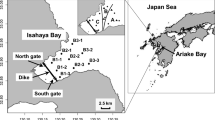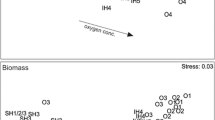Abstract
Bottom-water hypoxia in the northern Gulf of Mexico has increased in severity (duration, frequency, and intensity) since the 1970s and has impacted the less-mobile benthos ever since. From September 2003 to October 2004, the macrobenthic density, species richness, community composition, and vertical distribution were studied at a frequently hypoxic station, C6B (28°52.10′ N and 90°28.00′ W). The polychaete-dominated community was approximately three times less dense and diverse in post-hypoxic months compared to pre-hypoxic months. The lowest oxygen concentrations in July 2004 did not significantly affect the infaunal community as predicted; rather, the response was observed 1 month later after a longer, low-oxygen exposure. The opportunistic, hypoxia-tolerant polychaete, Paraprionospio pinnata, population increased in July 2004 when other common species decreased, thereby maintaining pre-hypoxic densities. Determining the duration and severity of hypoxia prior to sampling rather than at the time of sampling helps to better understand benthic community responses to hypoxia.









Similar content being viewed by others
References
Aller, R.C. 1988. Benthic fauna and biogeochemical processes in marine sediments: the role of burrow structures. In Nitrogen cycling in coastal marine environments, ed. T.H. Blackburn and J. Sorensen, 301–338. New York: Wiley.
Baustian, M.M., J.K. Craig, and N.N. Rabalais. 2009. Effects of summer 2003 hypoxia on macrobenthos and Atlantic croaker foraging selectivity in the northern Gulf of Mexico. Journal of Experimental Marine Biology and Ecology. In press.
Baden, S.P., L. Loo, L. Pihl, and R. Rosenberg. 1990. Effects of eutrophication on benthic communities including fish: Swedish west coast. Ambio 19: 113–122.
Boland, G.S. and G.T. Rowe. 1991. Deep-sea benthic sampling with the GOMEX box corer. Limnology and Oceanography 36: 1015–1020.
Breitburg, D.L., D.W. Hondorp, L.A. Davias, and R.J. Diaz. 2009. Hypoxia, nitrogen, and fisheries: Integrating effects across local and global landscapes. Annual Review of Marine Science 1: 329–349.
Burnett, L.E. and W.B. Stickle. 2001. Physiological responses to hypoxia. In Coastal hypoxia: Consequences for Living Resources and Ecosystems, ed. N.N. Rabalais and R.E. Turner, 101–114. Washington, DC: Coastal American Geophysical Union.
Clarke, K.R. and R.M. Warwick. 2001. Change in marine communities: an approach to statistical analysis and interpretation, 2nd ed. Plymouth: PRIMER-E. Plymouth Marine Laboratory.
Diaz, R.J. and R. Rosenberg. 1995. Marine benthic hypoxia: A review of its ecological effects and the behavioural responses of benthic macrofauna. Oceanography and Marine Biology: An Annual Review 33: 245–303.
Diaz, R.J. and R. Rosenberg. 2008. Spreading dead zones and consequences for marine ecosystems. Science 321: 926–929.
Dernie, K.M., M.J. Kaiser, and R.M. Warwick. 2003. Recovery rates of benthic communities following physical disturbance. Journal of Animal Ecology 72: 1043–1056.
Folk, R.L. 1974. Petrology of sedimentary rocks. Austin: Hemphill.
Gaston, G.R. 1985. Effects of hypoxia on macrobenthos of the inner shelf off Cameron, Louisiana. Estuarine Coastal and Shelf Science 20: 603–613.
Gaston, G.R. and K.A. Edds. 1994. Long-term study of benthic communities on the continental shelf off Cameron, Louisiana: A review of brine effects and hypoxia. Gulf Research Reports 9: 57–64.
Gray, J.S. and M. Elliott. 2009. Ecology of marine sediments. New York: Oxford University Press.
Harper Jr., D.E., L.D. McKinney, R.R. Salzer, and R.J. Case. 1981. The occurrence of hypoxic bottom water off the upper Texas coast and its effects on the benthic biota. Contribution in Marine Science 24: 53–79.
Hedges, J.I. and J.H. Stern. 1984. Carbon and nitrogen determinations of carbonate-containing solids. Limnology and Oceanography 29: 657–663.
Jørgensen, B.B. 1980. Seasonal oxygen depletion in the bottom waters of a Danish fjord and its effect on the benthic community. Oikos 34: 68–76.
Lamont, P.A. and J.D. Gage. 2000. Morphological responses of macrobenthic polychaetes to low oxygen on the Oman continental slope, NW Arabian Sea. Deep-sea Research 47: 9–24.
Mangum, C. and W. Van Winkle. 1973. Responses of aquatic invertebrates to declining oxygen conditions. American Zoologist 13: 529–541.
Murrell, M.C. and J.W. Fleeger. 1989. Meiofauna abundance on the Gulf of Mexico continental shelf affected by hypoxia. Continental Shelf Research 9: 1049–1062.
Niermann, U., E. Bauerfeind, W. Hickel, and H.V. Westerhangen. 1990. The recovery of benthos following the impact of low oxygen content in the German Bight. Netherlands Journal of Sea Research 25: 215–226.
Powers, S.P., D.E. Harper Jr., and N.N. Rabalais. 2001. Effects of hypoxia/anoxia on the supply and settlement of benthic invertebrate larvae. In Coastal hypoxia: Consequences for living resources and ecosystems, Coastal and Estuarine Studies 58, ed. N.N. Rabalais and R.E. Turner, 185–210. Washington, DC: American Geophysical Union.
Quiroga, E., Quiñones RA, R.R. González, V.A. Gallardo, and J. Gerdhard. 2007. Aerobic and anaerobic metabolism of Paraprionospio pinnata (Polychaeta: Spionidae) in central Chile. Journal of the Marine Biological Association of the United Kingdom 87: 459–463.
Rabalais, N.N., and D.E. Harper, Jr. 1992. Studies of benthic biota in areas affected by moderate and severe hypoxia, In Nutrient enhanced coastal ocean productivity, 48-51. Galveston: Texas Sea Grant College Program.
Rabalais, N.N., L.E. Smith, E.B. Overton, and A.L. Zoeller. 1993. Influence of hypoxia on the interpretation of effects of petroleum production activities. New Orleans: OCS Study/MMS 93-0022. U.S. Dept. of the Interior, Minerals Management Service, Gulf of Mexico OCS Region.
Rabalais, N.N., L.E. Smith, D.E. Harper Jr., and D. Justić. 2001a. Effects of seasonal hypoxia on continental shelf benthos. In Coastal hypoxia: Consequences for living resources and ecosystems, Coastal and Estuarine Studies 58, ed. N.N. Rabalais and R.E. Turner, 211–240. Washington, DC: American Geophysical Union.
Rabalais, N.N., D.E. Harper Jr., and R.E. Turner. 2001b. Responses of nekton and demersal and benthic fauna to decreasing oxygen concentrations. In Coastal hypoxia: Consequences for living resources and ecosystems, Coastal and Estuarine Studies 58, ed. N.N. Rabalais and R.E. Turner, 115–128. Washington, DC: American Geophysical Union.
Rabalais, N.N., R.E. Turner, and D. Scavia. 2002. Beyond science into policy: Gulf of Mexico hypoxia and the Mississippi River. BioScience 52: 129–142.
Rabalais, N.N. and R.E. Turner. 2006. Oxygen depletion in the Gulf of Mexico adjacent to the Mississippi River. In Past and present marine water column anoxia, ed. L.N. Neretin, 225–245. Dordrecht: Springer.
Rabalais, N.N., R.E. Turner, B.K. Sen Gupta, D.F. Boesch, P. Chapman, and M.C. Murrell. 2007. Hypoxia in the northern Gulf of Mexico: Does the science support the plan to reduce, mitigate, and control hypoxia? Estuaries and Coasts 30: 753–772.
Solan, M., B.J. Cardinale, A.L. Downing, K.A.M. Engelhardt, J.L. Rueskink, and D.S. Srivastava. 2004. Extinction and ecosystem function in the marine benthos. Science 306: 1177–1180.
Theede, H., A. Ponat, K. Hiroki, and C. Schlieper. 1969. Studies on the resistance of marine bottom invertebrates to oxygen-deficiency and hydrogen sulfide. Marine Biology 2: 325–337.
Turner, R.E., N.N. Rabalais, and D. Justić. 2008. Gulf of Mexico hypoxia: Alternate states and a legacy. Environmental Science and Technology 42: 2323–2327.
Vaquer-Sunyer, R. and C.M. Duarte. 2008. Thresholds of hypoxia for marine biodiversity. Proceedings of the National Academy of Sciences 105: 15452–15457.
Wetzel, M.A., J.W. Fleeger, and S.P. Powers. 2001. Effects of hypoxia and anoxia on meiofauna: a view with new data from the Gulf of Mexico. In Coastal hypoxia: Consequences for living resources and ecosystems, Coastal and Estuarine Studies 58, ed. N.N. Rabalais and R.E. Turner, 165–184. Washington, DC: American Geophysical Union.
Yokoyama, H. 1995. Occurrence of Paraprionospio sp. (form A) larvae (Polychaeta: Spionidae) in hypoxic waters of an enclosed bay. Estuarine and Coastal Shelf Science 40: 9–19.
Acknowledgments
This project was co-funded by Louisiana Universities Marine Consortium (LUMCON) and by National Oceanic and Atmospheric Administration (NOAA) Center for Sponsored Coastal Ocean Research grant no. NA03NOS4780037 to N. Rabalais. Our appreciation goes to J. Baustian, J. Lee, C. Milan, J. Plunket, L. Pride, K. Reynolds, and A. Sapp, for their field work participation. For laboratory assistance, we thank N. Atilla, L. Appelbaum, R. Carney, C. Milan, and R.E. Turner. Thank you to L. Pride for providing the continuous oxygen data and K. Sinclair and T. Widgeon for developing the map. Special thanks to four anonymous reviewers for improving our manuscript. This is publication number 116 of the NOAA CSCOR NGOMEX program.
Author information
Authors and Affiliations
Corresponding author
Electronic supplementary material
Below is the link to the electronic supplementary material.
Table S1
Benthic infaunal densities (individuals m−2) for 14 monthly triplicate samples used to calculate the mean. (DOC 43 kb)
Table S2
List of macroinfauna identified monthly at station C6B from September 2003 to October 2004 off the coast of Louisiana. *** Benthic organism could not be identified to family level. (DOC 82 kb)
Rights and permissions
About this article
Cite this article
Baustian, M.M., Rabalais, N.N. Seasonal Composition of Benthic Macroinfauna Exposed to Hypoxia in the Northern Gulf of Mexico. Estuaries and Coasts 32, 975–983 (2009). https://doi.org/10.1007/s12237-009-9187-3
Received:
Revised:
Accepted:
Published:
Issue Date:
DOI: https://doi.org/10.1007/s12237-009-9187-3




